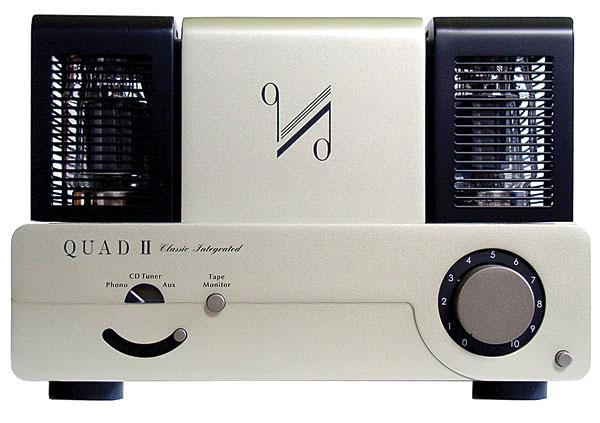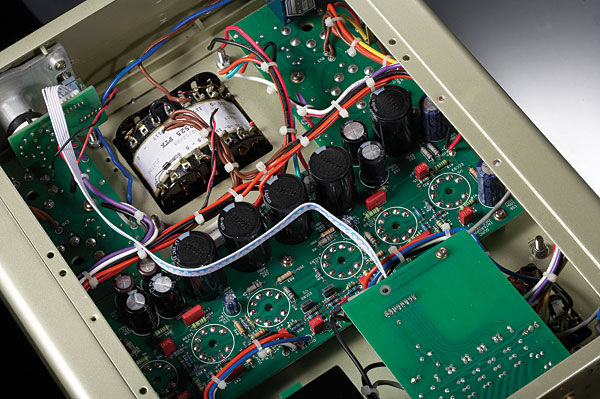| Columns Retired Columns & Blogs |
Quad II Classic Integrated amplifier

Given that Quad's founder, the late Peter J. Walker, wasn't around to design the Quad II Classic Integrated, the English firm relied instead on Tim de Paravicini, whose credits include the comparatively recent Quad II-eighty mono amplifiers and QC-twentyfour preamplifier (not to mention his own line of E.A.R./Yoshino electronics and countless other well-regarded products). It's with respect for both men that I say: In turning to Tim de Paravicini, Quad has probably chosen the closest approach to the original.
The new integrated is, essentially, a pair of Quad II amplifiers (ca 1953) powered with silicon rather than glass rectification and bundled with a perfectionist-quality control unit and a solid-state phono section. According to de Paravicini, the output section runs in pure class-A and is modeled after Walker's Acoustical circuit, in which a portion of the output transformer's primary winding is coupled to the cathodes of the KT66 output pentode tubes (as opposed to their screen grids, as in Ultralinear output circuits). Those transformers, of course, are designed by de Paravicini, and made in England to his very exacting specifications. The amp's output section is configured as autobias, and a bit of global feedback is used—although a less-than-typical amount is required, given that the Acoustical circuit itself provides local feedback, with apparently little loss of gain and power.
The small-signal tubes in the Quad II Classic—four 12AX7 dual-triodes and two 6922 dual-triodes—function as the phase splitter/driver stage for the voltage-hungry output section; the Quad's line stage is passive. The phono section is described as "a simple and elegant circuit with five transistors per channel." It's powered by a 36V drop from the rail voltage, and uses a combination of active and passive filters to achieve RIAA equalization. Gain is 42dB in moving-magnet mode, and 62dB when switched to moving-coil mode.

The Quad's innards are built on four PC boards: one for the input-switching relays, one each for the two pairs of output tubes, and one main board for the small-signal tubes and various power-supply components. (I never did locate a silicon full-wave rectifier, although I found a small diode bridge tucked away at the front edge of the main board.) The parts quality appeared to be fine—the output transformers were lovely to behold—and the build quality was excellent.
The casework and controls of the Quad II Classic are clearly influenced by the classic Quad 22 control preamplifier (ca 1959): The faceplate is shaped is the same manner, with a similarly big, beautiful volume control. The new Quad's source selector is a four-stop slider in a crescent-shaped slot with an old-style needle indicator above. From the outside, it gives that end of the Quad's faceplate a somewhat enigmatic smile. Not inappropriately.

Installation and setup
Unlike the Leben CS300 and Luxman SQ-38u integrated amps, which I also review in this issue, the Quad II Classic Integrated is physically deeper than it is wide; nevertheless, it fit well on the top shelf of my Box Furniture D3S rack, with all four feet making full contact with the wood surface (a requirement for optimal performance, I think, but that's a topic for another day). The full-function Quad replaced both my Shindo Masseto preamp and Shindo Corton-Charlemagne monoblocks, with no need for an external phono preamp. Per my usual practice, I fed the Quad's MM inputs with signals from my Auditorium 23 SPU Standard and Silvercore One-to-Ten phono transformers, rather than use just the Quad's switchable MC input with MC pickups—but the results weren't always what I expected. Whereas I tend to prefer loading and stepping-up a cartridge with a transformer rather than an active stage, the Quad's solid-state phono preamp seemed to narrow the gap between those two approaches, differences between which were subtle.
Again, my line-level sources were an Apple iMac equipped with Decibel playback software and a Wavelength Proton USB D/A converter, along with an aging Sony PlayStation for a CD player. Loudspeakers were my Audio Note AN-E/SPe HEs and, where indicated, my original Quad ESLs. I used only the Quad amp's stock AC cord. During all of my listening sessions, it was apparent that the Quad amp did not invert absolute signal polarity.
Listening
The first things that struck me about the Quad's sound were its up-front presentation—this wasn't at all a laid-back performance—and its readily apparent sense of drive with up-tempo music. The musical timing of all recordings was well preserved, although the Quad II Classic sounded especially fleet of foot with quick, snappy acoustic music such as David Grisman's "E.M.D.," from the first, eponymous album by the David Grisman Quintet (LP, Kaleidoscope F-5).
With line and phono sources alike, the Quad's midrange was lush and warm, with decent contrast between timbrally light and dark sounds in the mix, albeit less natural texture than I expected. In my system, driving the Audio Note cone-and-dome speakers, the Quad's most notable shortcoming was a lack of extension at the frequency extremes—especially the bottom end. Through the Quad II Classic, the dB's' "Happenstance," from their Repercussion (LP, Albion ALLP 400032J), sounded overly midrangey: the inverse of the rightly maligned hi-fi "scoop." There was fine punch and presence in the electric guitars, and the drumming sounded acceptably forceful, but the electric bass lacked that last bit of extension and power, and the Quad's slight lack of top-end sparkle conspired to make the voices sound a bit dull and lacking in presence.
Chamber music and very well-recorded symphonic fare were better served by the Quad's timbral balance. Of the former, the II Classic did a splendid job with the richly recorded sonorities of the Affetti Musicali's recording of Biber's Mysteriensonaten (CD, Winter & Winter 910 029-2). It missed a lot of the natural texture in that recording, but the Quad did allow the music to unfold with near-hypnotic intensity. As to the latter, recordist René Laflamme's masterful recording of Hindemith's Escale Romantique, performed by Daniel Myssyk and the Ensemble Instrumental (ripped from the Fidelio sampler Escales, no catalog number, www.fidelioaudio.com), was clear and spacious through the Quad amp, yet engagingly rich and warm.

Back to popular fare: Stevie Wonder's "Pastime Paradise," from Songs in the Key of Life (LP, Tamla T13-34062), sounded acceptably good through the Quad, but a little flat compared with my reference Shindo electronics; the latter did a distinctly better job of unraveling the sounds of the combined handclaps, strings, and percussion instruments. I also found myself wishing that those and other sounds would stand out more from the mix, and attain a greater sense of spatial presence.
Thus far I was charmed but unexcited by the Quad II Classic Integrated; replacing the conventional Audio Note loudspeakers with my original Quad ESLs turned up the passion considerably. Interestingly, the amp's lack of treble air—and commensurately midrangey sound—persisted, yet I found those characteristics to be far less objectionable when coupled with the naturally spacious presentation of the electrostatic panels. More important, I think, was the manner in which the amp and speakers jelled throughout the bass and lower midrange. "Überlin," from R.E.M.'s Collapse Into Now (CD, Warner Bros. 525611-2), worked very well through this combo, with fine instrumental sound and excellent momentum. And MoFi's recent reissue of the Band's Rock of Ages (SACD/CD, Capitol/Mobile Fidelity Sound Lab UDSACD 2046) sounded snappy, impactful, tonally well-balanced, and surprisingly spacious. The Quad-Quad combo let me enjoy that recording more than ever.
I was reluctant to turn back—and wound up spending more time with this pairing than I did with the Quad II Classic Integrated driving my Audio Notes. Through the electrostats, the Quad amp sounded brilliant with my favorite collection of Elgar's shorter works, by Paul Goodwin and the English Chamber Orchestra (CD, Harmonia Mundi HMU 907258). String tone was marvelous throughout, and the percussion that opens the third section of the Nursery Suite was appropriately startling, with more impact than Quad skeptics would expect. Even an admittedly grotty bootleg recording of Procol Harum playing "Repent Walpurgis" at the Fillmore East in 1969 (CD, Third Eye, no catalog number) sounded magnificent through this pairing—again, with surprisingly good impact on B.J. Wilson's masterful drumming and guitarist Robin Trower's feedback-drenched dive-bomb ending. The finest accolade I can offer any domestic playback machine applied here: It was satisfying.
Conclusions
Inasmuch as Quad Electroacoustics set out to recast their nearly-60-year old Quad II as a full-function integrated amp, they have thoroughly succeeded: The Quad II Classic Integrated offers the same basic sound—perhaps tidied up a bit—in tandem with a modern solid-state phono section, itself remarkable for blending well with its tubey surroundings. Also like the Quad II of old, the new amp lacks the openness and texture of some modern designs—but makes up for it by singing with Quad's own ESL, itself not known for playing well with modern children.
If Quad ESLs—perhaps even other electrostats—are your everyday speakers, and if your aesthetic sensibilities are tuned to its very vintage look and feel, the Quad II Classic Integrated will no doubt delight you.
- Log in or register to post comments




































